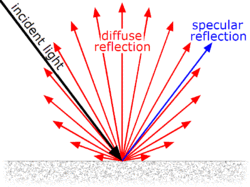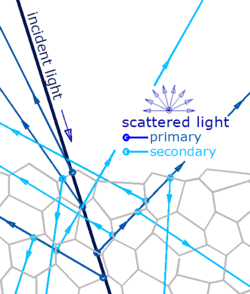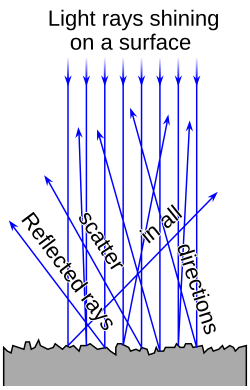Blender 3D:各种各样的教程

Diffuse reflection
is the
reflection
of
light
or other
waves
or
particles
from a surface such that a
ray
incident on the surface is
scattered
at many
angles
rather than at just one angle as in the case of
specular reflection
. An
ideal
diffuse reflecting surface is said to exhibit
Lambertian reflection
, meaning that there is equal
luminance
when viewed from all directions lying in the
half-space
adjacent to the surface.
::扩散反射是光或其他波或粒子从表面反射,使得光线在表面上发生的射线在许多角度分散而不是像镜面反射一样在一个角度.一个理想的扩散反射表面被认为具有兰伯特反射,这意味着从表面相邻的半空间中的所有方向观察时,光度均等.
A surface built from a non-absorbing powder such as
plaster
, or from fibers such as paper, or from a
polycrystalline
material such as white
marble
, reflects light diffusely with great efficiency. Many common materials exhibit a mixture of specular and diffuse reflection.
::表面由不吸收粉末 (如石膏),纤维 (如纸张) 或多晶材料 (如白色大理石) 构成,可以高效地分散反射光.许多常见材料具有光谱和分散反射的混合体.
The visibility of objects, excluding light-emitting ones, is primarily caused by diffuse reflection of light: it is diffusely-scattered light that forms the image of the object in an observer's eye over a wide range of angles of the observer with respect to the object.
::除了发光物体外,物体的可见性主要是由光的分散反射引起的:在观察者眼中,在观察者与物体的角度范围广泛的范围内,它是分散光散射的光.
Mechanism
::机制


Diffuse reflection from solids is generally not due to surface roughness. A flat surface is indeed required to give specular reflection, but it does not prevent diffuse reflection. A piece of highly polished white marble remains white; no amount of polishing will turn it into a mirror. Polishing produces some specular reflection, but the remaining light continues to be diffusely reflected.
::固体的分散反射通常不是由于表面粗.确实需要平面来产生反射,但它不能防止分散反射.一块高度抛光的白色大理石仍然是白色的;没有任何抛光将它变成镜子.抛光产生一些反射,但剩余的光仍然被分散反射.
The most general mechanism by which a surface gives diffuse reflection does not involve
exactly
the surface: most of the light is contributed by
scattering centers beneath the surface
,
[2]
[3]
as illustrated in Figure 1. If one were to imagine that the figure represents snow, and that the polygons are its (transparent) ice crystallites, an impinging ray is partially reflected (a few percent) by the first particle, enters in it, is again reflected by the interface with the second particle, enters in it, impinges on the third, and so on, generating a series of "primary" scattered rays in random directions, which, in turn, through the same mechanism, generate a large number of "secondary" scattered rays, which generate "tertiary" rays, and so forth.
[4]
All these rays walk through the snow crystallites, which do not absorb light, until they arrive at the surface and exit in random directions.
[5]
The result is that the light that was sent out is returned in all directions, so that snow is white despite being made of transparent material (ice crystals).
::表面发射的最普遍的反射机制并不完全涉及表面:大部分光线是由表面下分散中心贡献的,如图1所示.如果想象图形代表雪,而多边形是其 (透明) 冰晶体,撞击射线被第一个粒子部分反射 (百分之几),进入它,再次被第二个粒子的接口反射,进入它,撞击第三个,等等,产生一系列"初级"分散射线,反过来,通过同样的机制,产生大量"二级"分散射线,产生"三级射线",等等.尽管这些射线通过雪晶体走出,但它们不会随机吸收光,直到它们到达冰晶体,从而使雪晶体表面呈透明,因此光线被发送回来.
For simplicity, "reflections" are spoken of here, but more generally the interface between the small particles that constitute many materials is irregular on a scale comparable with light wavelength, so diffuse light is generated at each interface, rather than a single reflected ray, but the story can be told the same way.
::为了简单化,这里说的是"反射",但更一般地说,构成许多材料的小粒子之间的界面在与光波长相比的尺度上是不规则的,因此在每个界面上产生分散光,而不是单一的反射射线,但故事可以用同样的方式讲述.
This mechanism is very general, because almost all common materials are made of "small things" held together. Mineral materials are generally
polycrystalline
: one can describe them as made of a 3D mosaic of small, irregularly shaped defective crystals. Organic materials are usually composed of fibers or cells, with their membranes and their complex internal structure. And each interface, inhomogeneity or imperfection can deviate, reflect or scatter light, reproducing the above mechanism.
::矿物质通常是多晶体的:人们可以将它们描述为由小的3D马赛克组成的,不规则的形状有缺陷的晶体.有机材料通常由纤维或细胞组成,具有膜和复杂的内部结构.每个接口,不均或不完美可以偏离,反射或散射光,重现上述机制.
Few materials do not cause diffuse reflection: among these are metals, which do not allow light to enter; gases, liquids, glass, and transparent plastics (which have a liquid-like
amorphous
microscopic structure);
single crystals
, such as some gems or a salt crystal; and some very special materials, such as the tissues which make the
cornea
and the
lens
of an eye. These materials can reflect diffusely, however, if their surface is microscopically rough, like in a
frost glass
(Figure 2), or, of course, if their homogeneous structure deteriorates, as in
cataracts
of the eye lens.
::很少有材料不会引起散射反射:其中包括不允许光进入的金属,气体,液体,玻璃和透明塑料 (具有液态无形的微观结构),单晶,如一些宝石或盐晶,以及一些非常特殊的材料,如眼睛的角膜和透镜的组织.然而,如果它们的表面微观粗,如玻璃 (图2),或者,当然,如果它们的均结构恶化,如眼睛透镜的白内障,这些材料可以散射反射.
A surface may also exhibit both specular and diffuse reflection, as is the case, for example, of
glossy
paints
as used in home painting, which give also a fraction of specular reflection, while
matte
paints give almost exclusively diffuse reflection.
::表面也可能呈现光反射和光散反射,例如,在家居涂料中使用的光泽涂料,也会产生很少的光反射,而色涂料几乎只能产生光散反射.
Most materials can give some specular reflection, provided that their surface can be polished to eliminate irregularities comparable with the light wavelength (a fraction of a micrometer). Depending on the material and surface roughness, reflection may be mostly specular, mostly diffuse, or anywhere in between. A few materials, like liquids and glasses, lack the internal subdivisions which produce the subsurface scattering mechanism described above, and so give
only
specular reflection. Among common materials, only polished metals can reflect light specularly with high efficiency, as in aluminum or silver usually used in mirrors. All other common materials, even when perfectly polished, usually give not more than a few percent specular reflection, except in particular cases, such as
grazing angle
reflection by a lake, or the
total reflection
of a glass prism, or when structured in certain complex configurations such as the silvery skin of many fish species or the reflective surface of a
dielectric mirror
. Diffuse reflection can be highly efficient, as in white materials, due to the summing up of the many subsurface reflections.
::大多数材料可以产生一些镜面反射,前提是它们的表面可以被抛光以消除与光波长 (微米的一小部分) 相比的不规则.根据材料和表面粗度,反射可能主要是镜面,主要是扩散,或介于两者之间的任何地方.一些材料,如液体和玻璃,缺乏产生上述地下散射机制的内部细分,因此只产生镜面反射.在常见材料中,只有抛光的金属可以高效率地反射光,如通常用于镜面的或银.所有其他常见材料,即使是完美抛光,通常不会超过几百分比的镜面反射,除非在特殊情况下,如鱼湖的放牧角度反射,或镜的反射,或在某些复杂的结构中,如许多物种银色的皮肤或
Colored objects
::彩色的物体
Up to this point white objects have been discussed, which do not absorb light. But the above scheme continues to be valid in the case that the material is absorbent. In this case, diffused rays will lose some wavelengths during their walk in the material, and will emerge colored.
::到目前为止,我们已经讨论过白色物体,它们不吸收光.但在这种情况下,在材料吸收的情况下,上述方案仍然有效.在这种情况下,扩散的射线在材料中漫步时会失去一些波长,并会出现颜色.
Diffusion affects the color of objects in a substantial manner because it determines the average path of light in the material, and hence to which extent the various wavelengths are absorbed.
[6]
Red ink looks black when it stays in its bottle. Its vivid color is only perceived when it is placed on a scattering material (e.g. paper). This is so because light's path through the paper fibers (and through the ink) is only a fraction of millimeter long. However, light from the bottle has crossed several centimeters of ink and has been heavily absorbed, even in its red wavelengths.
::扩散会对物体的颜色产生很大影响,因为它决定了材料中的平均光线路径,因此不同波长的光线被吸收到的程度.[6]红色墨水在瓶中看起来是黑色的.它的鲜色彩只有在散射材料 (例如纸) 上才被感知到.这是因为光线穿过纸纤维 (和通过墨水) 的路径只有几分之一毫米长.然而,来自瓶中的光线已经穿过几厘米的墨水,并且即使在红色波长中也被大量吸收.红色墨水的光线也会通过红色墨水的光线.
And, when a colored object has both diffuse and specular reflection, usually only the diffuse component is colored. A cherry reflects diffusely red light, absorbs all other colors and has a specular reflection which is essentially white (if the incident light is white light). This is quite general, because, except for metals, the reflectivity of most materials depends on their
refractive index
, which varies little with the wavelength (though it is this variation that causes the
chromatic dispersion
in a
prism
), so that all colors are reflected nearly with the same intensity.
::桃反射红色光,吸收所有其他颜色,并具有基本上是白色的反射 (如果落下的光是白色光).这是相当普遍的,因为,除金属外,大多数材料的反射率取决于它们的折射率,这与波长差异很小 (尽管这种变化导致镜中的色谱分散),因此所有颜色都几乎具有相同的强度.
Importance for vision
::对视力的重要性
The vast majority of visible objects are seen primarily by diffuse reflection from their surface.
[7]
[8]
Exceptions include objects with polished (specularly reflecting) surfaces, and objects that themselves emit light.
Rayleigh scattering
is responsible for the blue color of the sky, and
Mie scattering
for the white color of the water droplets in clouds.
::大多数可见物体主要通过它们表面的扩散反射来被看到. [1] [2] 例外包括表面光滑 (特别反射) 的物体和本身发光的物体.雷利散射是导致天空蓝色的原因,而米散射则是导致云中的水滴白色的原因.
Interreflection
::互反射
Diffuse interreflection
is a process whereby
light
reflected from an object strikes other objects in the surrounding area, illuminating them. Diffuse interreflection specifically describes light reflected from objects which are not shiny or
specular
. In real life terms what this means is that light is reflected off non-shiny surfaces such as the ground, walls, or fabric, to reach areas not directly in view of a light source. If the diffuse surface is
colored
, the reflected light is also colored, resulting in similar coloration of surrounding objects.
::散射反射是指从一个物体反射到周围的其他物体,从而照亮它们的过程.散射反射是指从不闪亮或反光物体反射的光.在现实生活中,这意味着光反射到地面,墙壁或布料等非闪亮表面,以达到不直接看到光源的区域.如果散射表面有色,反射光也会有色,从而导致周围物体的类似色彩.
In
3D computer graphics
, diffuse interreflection is an important component of
global illumination
. There are a number of ways to model diffuse interreflection when rendering a scene.
Radiosity
and
photon mapping
are two commonly used methods.
::在3D计算机图形中,分散反射是全球照明的重要组成部分.在染场景时,有多种方法可以模拟分散反射.射线度和光子映射是常用的两种方法.
Spectroscopy
::谱学
Diffuse reflectance spectroscopy
can be used to determine the absorption spectra of powdered samples in cases where transmission spectroscopy is not feasible. This applies to
UV-Vis-NIR
spectroscopy or
mid-infrared spectroscopy
.
[9]
[10]
::扩散反射光谱可以用于确定粉样的吸收光谱,在这种情况下,传输光谱是不可行的.这适用于UV-Vis-NIR光谱或中红外光谱. [1] [2]